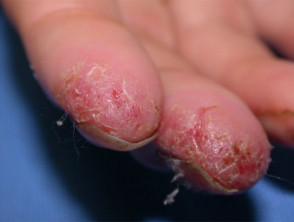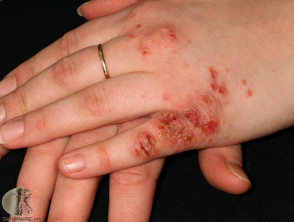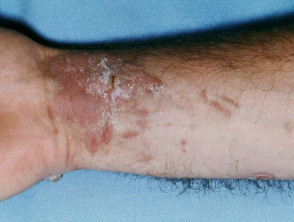Introduction
Beauticians represent a fairly large profession worldwide. Their occupation is associated with work-related skin disorders, including contact dermatitis and mechanical injury among others. In one study in Poland, for instance, it was found that 21% of hair stylists and beauticians had some form of occupational skin disease.
Why are beauticians at a high risk for occupational skin disorders?
There are many factors which put beauticians at a high occupational risk, including:
- A large amount of wet work due to contact with water while shampooing
- Exposure to a variety of preservatives, hair dyes, fragrances, and other chemicals in many beauty products, including formaldehyde, acetone, and paraphenylenediamine
- Exposure to sharp instruments including scissors and razors
- Exposure to cleaning chemicals and disinfectants
- Frequent use of latex gloves which can lead to the development of latex allergy and contact allergy to rubber accelerants
- A preponderance of low-paid workers with low education levels
- Lack of sufficient regulation in many countries.
In many studies of occupational dermatitis, beauticians are cited as being at the highest risk for developing work-related skin disorders.
Understanding occupational skin disorders
An occupational skin disorder is a dermatological condition brought on due to a patient’s job or work duties and is also called an occupational dermatosis. Occupational dermatoses are responsible for many lost days or work. The patient may have to change professions due to ongoing skin disease. These dermatoses can be brought about through work-related exposure to allergens, irritants, extreme weather conditions, and solar radiation. Occupational skin disorders have a large economic impact on employers and employees.
Skin disorders associated with beauticians
There are several specific skin disorders associated with work as a beautician. They include:
Mechanical injury
Mechanical injury to the skin often results from contact with scissors, razors or other tools/equipment.
- It can lead to secondary bacterial skin infections, especially from Staphylococcus aureus or Streptococcus pyogenes.
- Risk can be reduced by training the employee in handling sharps and by an employer being committed to providing safe and up-to-date tools.
Irritant contact dermatitis
Irritant contact dermatitis is more common than allergic contact dermatitis.
- The main cause of irritant contact dermatitis is “wet work”, or a high amount of exposure to water as well as soaps, and shampoos during client care and hand-washing.
- Irritation stems from constant removal of the skin’s natural moisturising factors during wet work.
- Younger beauticians, who do a proportionally higher amount of shampooing, are at greater risk of irritant contact dermatitis than senior beauticians.
- Risk can be mitigated by the use of gloves for hand protection during wet work.
Allergic contact dermatitis
Allergic contact dermatitis is common among beauticians.
- Together, allergic and irritant contact dermatitis accounts for 90% of occupational skin disorders for beauticians.
- Allergic contact dermatitis causes inflammation, dryness, itching and/or pain in skin exposed to the allergen.
- Those with a history of atopy (especially atopic eczema) are at a higher risk.
- The skin will often improve when away from work but regress when work is resumed.
- Common causes include rubber gloves, fragrances, preservatives, and hair dye.
Phytophotodermatitis
Phytophotodermatitis is not as widespread among beauticians as contact dermatitis, but is still a risk.
- Occupational phytophotodermatitis is caused by exposure of the skin first to perfumes or eau de cologne and then to sunlight (berloque dermatitis).
- It can result in hyperpigmentation of the skin.
- Risk can be reduced by proper use of gloves.
Contact urticaria
Contact urticaria refers to the rapid onset of itchy weals on contact with an allergen or irritant in a susceptible individual. Causes may include latex rubber and hair bleach.
Skin conditions that are common in beauticians
Workplace risk assessment
In order to be effective, a workplace must be assessed for:
- Protocols for specific tasks (such as giving a pedicure),
- The chemicals that workers are exposed to and their individual dangers
- The level of employee education in regards to limiting exposure to chemicals, safe handling, and disposal of sharps
- Use and provision of personal protective equipment.
Once risks have been identified, reducing these risks can include any of the following:
- Selecting milder, dye- and fragrance-free products and less toxic disinfectants and cleaners
- Employee education on the safe handling of sharps
- Employee education on the use of personal protective equipment
- The commitment of both employer and employees to workplace safety.
Personal protective equipment
Gloves for hand protection are the most commonly used form of personal protective equipment among beauticians. It has been shown that the use of gloves can reduce exposure to a variety of irritants and allergens. However, if gloves contain latex or accelerants like thiuram, they can become allergens themselves. Use of non-latex gloves and training on their proper donning and disposal can reduce these problems.
Nail technicians particularly tend to wear face masks for prolonged periods which can result in various skin reactions.
Hand care advice for beauticians
Hand care advice includes:
- Proper use of gloves (see above)
- Good handwashing and use of alcohol-based gels or sanitisers where appropriate
- Drying hands thoroughly after washing them
- Use of emollients and moisturisers
- Recognition of the early signs of dermatitis
- Seeking medical help if signs and symptoms appear.
Diagnosis and treatment of occupational skin disorders
Diagnosis of an occupational skin disorder can be based on:
- Thorough patient history and physical examination
- Patient occupational assessment to learn work history, conditions, chemicals, or other hazards at a patient’s place of work, use of protective equipment, etc.
- Patch testing if allergic contact dermatitis is suspected.
Treatment of dermatitis can include:
- Avoidance of the allergen or irritant (skin can recover in a matter of several weeks with total avoidance)
- Use of emollients
- Use of gloves
- Use of topical and/or oral corticosteroids to reduce inflammation
- Referral to a dermatologist if skin problem persists or resists simple treatments.


